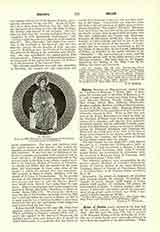

Helen of Skofde, Saint, martyr in the first half of the twelfth century. Her feast is celebrated July 31. Her life (Acta SS., July, VII, 340) is ascribed to St. Brynolph, Bishop of Skara, in Sweden (d. 1317). She was of noble family and is generally believed to have been the daughter of the Jarl Guthorm. When her husband died she remained a widow and spent her life in works of charity and piety; the gates of her home were ever open to the needy and the church of Skofde was almost entirely built at her expense. Her daughter’s husband was a very cruel man, and was in consequence killed by his own servants. His relatives, wishing to avenge his death, examined the servants. These admitted the crime, but falsely asserted that they acted on the instigation of Helen. She had then gone on a pilgrimage to the Holy Land, but on her return she was killed 1160 (?) at Gothene by her husband’s relatives. Her body was brought to Skofde for burial, and many wonderful cures were wrought at her intercession. The report of these miracles was sent to Rome by Stephen, the Archbishop of Upsala, and he, by order of Pope Alexander III, in 1164 inscribed her name in the list of canonized saints (Benedict XIV, “De canonizatione sanctorum”, I, 85). Great was the veneration shown her relics even after the Reformation had spread in Sweden. Near her church was a holy well, known to this day as St. Lene Kild. At various times the Lutheran authorities inveighed against this remnant of what they called popish and anti-Christian superstition. Especially zealous in this regard was Archbishop Abraham, who had all the springs, mineral or pure water, filled up with stones and rubbish (Baring-Gould, “Lives of the Saints”, July, II, 698). St. Helen’s tomb and well (St. Elin’s) were also honored at Tiisvilde in the parish of Tibirke in the island of Zealand. Pilgrimages were made every summer, cripples and sick came in numbers; they would remain all night at the grave, take away with them little bags of earth from under the tombstone, and frequently would leave their crutches or make votive offerings in token of gratitude. Such was the report sent in 1658 from Copenhagen to the Bollandists by the Jesuit Lindanus. A similar statement is made by Werlaiff, in 1858, in his “Hist. Antegnelser”. The legend says that St. Helen’s body floated to Tiisvilde in a stone coffin, and that a spring broke forth where the coffin touched land. The Bollandists (loc. cit.) give as a possible reason for her veneration at Tiisvilde that perhaps St. Helen had visited the place, or some of her relics had been brought there.
FRANCIS MERSHMAN

